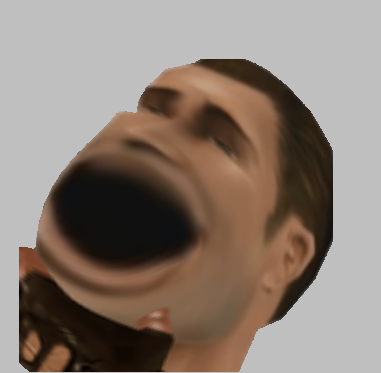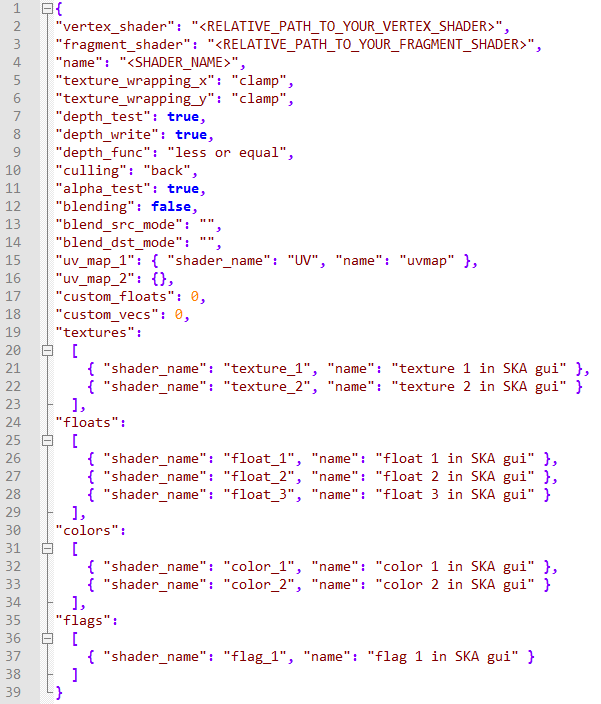A small utility library for using OpenGL 3.3 shaders in vanilla Serious Sam The Second Encounter v1.07 game.
- Who is this for?
- Installation
- Default shaders
- Basic usage
- What does not work
- License
- 3rd party notice
This library is usable both for those who are creating custom maps and for those who develop mods using Serious Sam's SDK 1.07 via Visual Studio 6.0 compiler.
This library is not well tested, but has been confirmed to work on multiple NVIDIA cards.
To install this library, go to the releases github page and download the latest zip file. Extract it to your Serious Sam TSE 1.07 root directory. Steam version should work too.
Clone this repository and place content of Sources directory inside SDK's Sources directory, so that 'GLShaders' directory and, for example, 'EntitiesMP' are on the same level. If you are willing to recompile this library from sources, add GLShaders.dsp project to your workspace as a dependency of EntitiesMP, provide link and include directories for glew and jansson third-party libraries and you are ready to go.
SamGLShaders provides some shaders as example on how to use this library. Here is their description:
GL3 Base- simple shader that tries to mimic the look and feel of Serious Sam's defaultBaseshader in SKAStudio
GL3 Lul- shader that demonstrates usage of sprite in vertex program, and dynamic texture mapping in fragment program
GL3 Reflection- shader that uses cubemaps to render reflections
-
GL3 Sprite- this shader is meant to show how shader profiles work in terms of directory and file structure -
GL3 SS2 Standard- shader that tries to mimic basic look and feel of Serious Sam 2 model rendering
GL3 SS3 Standard- shader that tries to mimic basic look and feel of Serious Sam 3 model rendering
GL3 Water- this shader is an example of how to render a simple water surface
SamGLShaders uses SKA models. They are very convenient, mostly because they enable this whole project to work. With SKA models, a 'shader' concept was introduced to the Serious Engine. While default shaders are not shaders at all in our modern sense of this word, they provide a very important property - ability to modify rendering pipeline. SamGLShaders, due to limitations of it being an add-on on top of the vanilla engine, introduces the concept of 'shaders profile'.
A Shader profile is simply a set of 20 shaders. While number 20 is pretty limited and has been picked arbitrarily, the number of profiles is not limited at all.
IMPORTANT - Before we continue, it must be noted that SamGLShaders library does NOT use textures that are provided by Serious Engine. Instead, it tries to load .tga source of that texture to support greater resolution. However, regular .tex textures are still required as placeholders for SKAStudio and the engine itself.
Here is a structure of Shaders directory, that is used to store your shaders:
Is a simple text file, that defines index of a shader that it describes. Shader entry point is not linked to a particular shader profile, it only tells engine the name of a shader, and its number in currently enabled profile.
Here is a content of GL3 Base.sha file:
Package: TFNM Bin\GLShadersMP.module
Name: Shader_GLShader_1
Info: Shader_Desc_GLShader_1
In general, proper content should strictly follow this pattern:
Package: TFNM Bin\GLShadersMP.module
Name: Shader_GLShader_<NUMBER_BETWEEN_1_AND_20>
Info: Shader_Desc_GLShader_<SAME_NUMBER_AS_ABOVE>
As stated above, shader entry point is not linked to a profile, the profile itself is bound dynamically by an external entity, like GLModelHolder, which is set up by user. Because SKAStudio cannot have entities and only serves as a model viewer, the contents of this file are interpreted as a name of a profile that should be enabled by default. That means, when you want to create your new custom shader profile (which you should always do to be compatible with all other possible shaders), you should edit this file and make sure that your profile's name is saved in it. While one profile is enabled, SKAStudio CAN NOT work with shaders from other profiles! The game itself works fine though.
Basically, its a directory that can contain up to 20 shaders. Here is a structure of a typical shader profile:
Is a json plain text file, that describes shader and defines is properties. All shader description files should be called by this pattern:
GLShader_<NUMBER_BETWEEN_1_AND_20>.json
Here is a quick overview of what can be written in a typical json for your shader:
Lets look closer at each field:
-
vertex_shader- relative path to your vertex shader. -
fragment_shader- relative path to your fragment shader. -
name- shader name, not really used, just a quick description of shader. -
texture_wrapping_xtexture_wrapping_y- these two parameters describe how textures are wrapped. Possible values: clamp, repeat -
depth_test- enables depth testing. -
depth_write- enables depth writing. -
depth_func- comparison that determines whether fragment is close enough to be visible. Possible values: never, less, less or equal, equal, not equal, greater or equal, greater, always. -
culling- determines which faces are culled. Possible values: front, back, none. -
alpha_test- if enabled, fragmens with less than half alpha channel are considered transparent. -
blending- enables blending. -
blend_src_modeblend_dst_mode- these two parameters specify coefficients that are applied to blend function. Possible values: one, zero, src color, inv src color, dst color, inv dst color, src alpha, inv src alpha. -
uv_map_1uv_map_2- these two parameters describe GLSL uniforms that are used to identify UV maps. Only two UV maps are supported simultaniously. All uniform values are json objects that have two fields:shader_name- name of corresponding variable in your shader source code.name- how it is displayed in SKAStudio GUI.
-
custom_floats- number of custom float uniforms, provided for shader. Useful only for programmers, more details about this below. -
custom_vecs- numver of custom vec3 uniforms, provided for shader. Similar to custom_floats. -
textures- array of objects that describe texture uniform variables. Quantity potentially unlimited. Supported texture samplers are: sampler2D, samplerCube. -
floats- array of objects that describe float uniform variables. Quantity potentially unlimited. -
colors- array of objects that describe vec3 uniform variables for colors. Quantity potentially unlimited. -
flags- array of objects that describe boolean uniform variables. Maximum number is 8.
Are actual GLSL code that does all the job. To learn more about GLSL, please read proper documentation, books, use google, whatever. GLSL help is not provided here and to use this library you have to know how to write OpenGL shaders.
Obviously, for shaders to actually work, library has to provide some predefined uniforms and variables:
uniform mat4 projMx- projection matrixuniform mat4 viewMx- view matrixuniform mat4 modelMx- model matrixuniform vec3 lightDir- light direction in world-spaceuniform vec3 colLight- light coloruniform vec3 colAmbient- light ambient coloruniform float time- current ingame timelayout(location = 0) in vec3 posModel- vertex coordinates, already in world-spacelayout(location = 1) in vec2 vertexUV1- UV Map 1 coordinateslayout(location = 2) in vec3 normalModel- fragment normal vector, in model-spacelayout(location = 3) in vec3 tangentModel- fragment tangent vector (used in normal mapping)layout(location = 4) in vec3 bitangentModel- fragment bitangent vector (used in normal mapping)layout(location = 5) in vec2 vertexUV2- UV Map 2 coordinates
GLShaders library provides three new entities for use in Serious Editor. They can be added to your Editor's virtual tree through ecl files in Classes directory:
This entity gives ability to properly use SKA models in your level with your shaders.
GLModelHolder entity also has a special field GL Profile that defines directory, from which its shaders should be loaded. Set this field before loading proper .smc model.
This entity provides ability to play animations for targeted GLModelHolder. Desired animation is provided in form of string value, that is stored in Animation Name property.
This is a utility entity, used only to create cubemaps.
To easily create a cubemap, place this entity in the desired position and check its Press to bake property.
A "Save File" dialog shall appear, asking you where to save the cubemap. In case of success, you should get something similar to this:
NOTE: the generated .tex file is just a placeholder.
To show all new custom entities in action, an example level is provided:
GLResources\Examples\ExampleLevel.wld
Follow these simple steps:
- Create your custom shader profile directory inside
Shadersdirectory. For example,Shaders\MyProfile - Create a shader entry point file with desired name and index that is free in your profile. For example,
Shaders\My Shader.sha - Create shader description json file and properly set it up. For example,
Shaders\MyProfile\GLShader_1.json - Create actual shader source files. For example,
Shaders\MyProfile\MyShader.vertandShaders\MyProfile\MyShader.frag - Before launching SKAStudio, edit the
Shaders\GLDefaultProfilefile so it contains your profile name, i.e.MyProfile - Launch SKAStudio, setup your model and shader and work on them until you are happy with the results.
- Launch SeriousEditor, place a GLModelHolder entity on the map, edit its
GL Profileproperty so it isMyProfileand select your model with your custom shader.
As an exercise you can use and explore provided GL3 Sprite shader.
To use GLShaders in your custom dll for Serious Sam 1.07, a GLShadersMP.lib and GLShadersMPD.lib libraries are provided in bin directory. But you can always recompile them from source code if you desire so.
There are three main include files that provide API:
#include <GLShaders/RenderSessionAPI.h>
#include <GLShaders/ShaderProfileAPI.h>
#include <GLShaders/ModelMatrix.h>File ModelMatrix.h provides variables that are used to compute model matrix for shader. As engine premultiplies vertex data with model matrix internally, there is no easy way to get that info at the library level, so the easiest way is to provide this information manually before draw call.
extern ALEX_API float g_AlexShaders_modelMatrix_pos0;
extern ALEX_API float g_AlexShaders_modelMatrix_pos1;
extern ALEX_API float g_AlexShaders_modelMatrix_pos2;
extern ALEX_API float g_AlexShaders_modelMatrix_ang0; // angles are in degrees and not radians
extern ALEX_API float g_AlexShaders_modelMatrix_ang1;
extern ALEX_API float g_AlexShaders_modelMatrix_ang2;File RenderSessionAPI.h exposes these functions:
// call this function to initialize this library. Returns true on success
ALEX_API bool AlexShaders_Initialize();
// call this function when you want to deinitialize the library
ALEX_API void AlexShaders_Finalize();
// basic check
ALEX_API bool AlexShaders_Initialized();
// render session is a unique set of parameters used to draw one particular model
// create unique render session for each model and always set it before drawing
ALEX_API int AlexShaders_RegisterRenderSession();
// set render session to be used
ALEX_API void AlexShaders_SetRenderSession(int renderSession);
// reset all sessions. This function is not normally used
ALEX_API void AlexShaders_ClearAllSessions();
// a helper function to load textures for particular CModelInstance onto GPU
ALEX_API void AlexShaders_Precache(CModelInstance& modelInstance);
// set address, from which custom float uniforms are taken
// number of these floats is determined in JSON config
ALEX_API float* AlexShaders_SetCustomFloatPool(float* customFloatPool);
// set address, from which custom vec3 uniforms are taken
// number of these vec3's is determined in JSON config. vec3 is simply three consequent floats
ALEX_API float* AlexShaders_SetCustomVecPool(float* customVecPool);And finally ShaderProfileAPI.h provides following APIs:
// call this function to create new shader profile, which will load shaders from Shaders/<loadingDir>
ALEX_API int AlexShaders_CreateShaderProfile(const char* loadingDir);
// set render profile to be used. Return value is previously active profile
ALEX_API int AlexShaders_SetCurrentProfile(int newProfile);
// gets currently active profile. This function is not normally used
ALEX_API int AlexShaders_GetCurrentProfile();A good example of how to use these API's is source code of GLModelHolder entity, located in GLModelHolder.es file.
- Haze
- Fog
- DirectX (nobody sane needs DirectX anyway)
This library uses GPL v3, for more info, read file LICENSE
glew - Modified BSD license
glm - Modified MIT license
jansson - MIT license
stb_image - public domain













